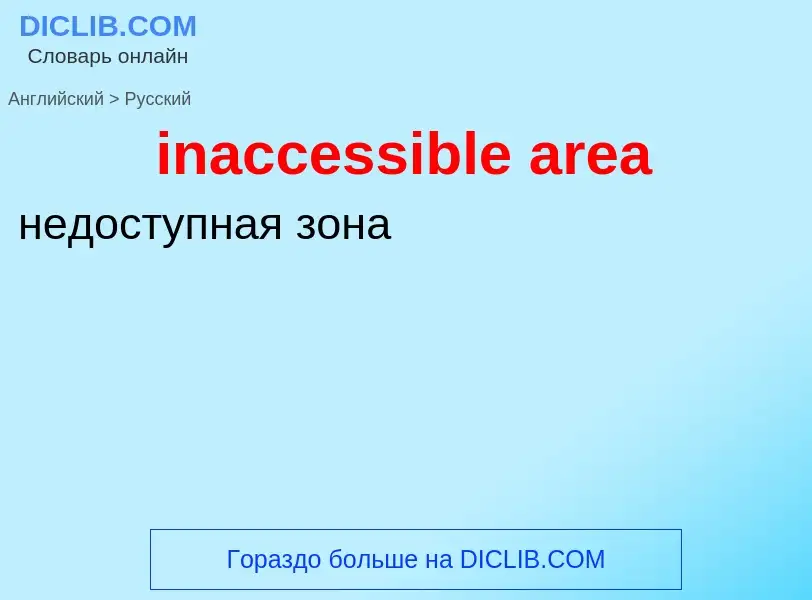Перевод и анализ слов искусственным интеллектом ChatGPT
На этой странице Вы можете получить подробный анализ слова или словосочетания, произведенный с помощью лучшей на сегодняшний день технологии искусственного интеллекта:
- как употребляется слово
- частота употребления
- используется оно чаще в устной или письменной речи
- варианты перевода слова
- примеры употребления (несколько фраз с переводом)
- этимология
inaccessible area - перевод на русский
математика
недостижимое кардинальное число
математика
слабо недостижимый
математика
сильно недостижимый
общая лексика
тристанский пастушок (Atlantisia rogersi)
- closed area
- controlled area
- controlled access area
- fenced area
- fingerprint pattern area
- high risk area
- inaccessible area
- key area
- limited area
- logically protected area
- monitored area
- physically protected area
- protected area
- restricted area
- secret area
- secure area
- secure storage area
- security-sensitive area
- survey area
- target area
- user area
['e(ə)riə]
общая лексика
область
район
зона
ареал
область обитания
площадь
пространство
участок
область, участок
область памяти, часть экрана
сфера деятельности
область специализации
медицина
место
плоскость
строительное дело
площадь (помещения, поверхности, фигуры и т. п.)
площадка
внутренний двор
пространство, зона
приямок (напр. у окна подвального этажа)
нефтегазовая промышленность
поверхность
зона, район, область, территория, участок
существительное
общая лексика
площадь
пространство
участок
район
область
зона
сфера (деятельности)
область (исследования и т. п.)
размах
охват
сфера
проход
ведущий к входу в подвал
приямок перед окнами подвального этажа
площадь, пространство
край
размах, сфера
дворик ниже уровня улицы, через который проходят в полуподвал
анатомия
поле (коры головного мозга)
синоним
Википедия
In set theory, an uncountable cardinal is inaccessible if it cannot be obtained from smaller cardinals by the usual operations of cardinal arithmetic. More precisely, a cardinal κ is strongly inaccessible if it is uncountable, it is not a sum of fewer than κ cardinals smaller than κ, and implies .
The term "inaccessible cardinal" is ambiguous. Until about 1950, it meant "weakly inaccessible cardinal", but since then it usually means "strongly inaccessible cardinal". An uncountable cardinal is weakly inaccessible if it is a regular weak limit cardinal. It is strongly inaccessible, or just inaccessible, if it is a regular strong limit cardinal (this is equivalent to the definition given above). Some authors do not require weakly and strongly inaccessible cardinals to be uncountable (in which case is strongly inaccessible). Weakly inaccessible cardinals were introduced by Hausdorff (1908), and strongly inaccessible ones by Sierpiński & Tarski (1930) and Zermelo (1930).
Every strongly inaccessible cardinal is also weakly inaccessible, as every strong limit cardinal is also a weak limit cardinal. If the generalized continuum hypothesis holds, then a cardinal is strongly inaccessible if and only if it is weakly inaccessible.
(aleph-null) is a regular strong limit cardinal. Assuming the axiom of choice, every other infinite cardinal number is regular or a (weak) limit. However, only a rather large cardinal number can be both and thus weakly inaccessible.
An ordinal is a weakly inaccessible cardinal if and only if it is a regular ordinal and it is a limit of regular ordinals. (Zero, one, and ω are regular ordinals, but not limits of regular ordinals.) A cardinal which is weakly inaccessible and also a strong limit cardinal is strongly inaccessible.
The assumption of the existence of a strongly inaccessible cardinal is sometimes applied in the form of the assumption that one can work inside a Grothendieck universe, the two ideas being intimately connected.

.jpg?width=200)





![A [[study skin]] of the Inaccessible Island rail A [[study skin]] of the Inaccessible Island rail](https://commons.wikimedia.org/wiki/Special:FilePath/Naturalis Biodiversity Center - ZMA.AVES.14292 - Atlantisia rogersi Lowe, P.R. , 1923 - Rallidae - skin specimen.jpeg?width=200)





![HMS ''Challenger'']] HMS ''Challenger'']]](https://commons.wikimedia.org/wiki/Special:FilePath/Rockhopper inaccessible.jpg?width=200)
